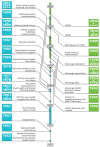Implementation of the Community-based Health Planning and Services (CHPS) in rural and urban Ghana: a history and systematic review of what works, for whom and why
- PMID: 37435526
- PMCID: PMC10332345
- DOI: 10.3389/fpubh.2023.1105495
Implementation of the Community-based Health Planning and Services (CHPS) in rural and urban Ghana: a history and systematic review of what works, for whom and why
Abstract
Background: Despite renewed emphasis on strengthening primary health care globally, the sector remains under-resourced across sub-Saharan Africa. Community-based Health Planning and Services (CHPS) has been the foundation of Ghana's primary care system for over two decades using a combination of community-based health nurses, volunteers and community engagement to deliver universal access to basic curative care, health promotion and prevention. This review aimed to understand the impacts and implementation lessons of the CHPS programme.
Methods: We conducted a mixed-methods review in line with PRISMA guidance using a results-based convergent design where quantitative and qualitative findings are synthesized separately, then brought together in a final synthesis. Embase, Medline, PsycINFO, Scopus, and Web of Science were searched using pre-defined search terms. We included all primary studies of any design and used the RE-AIM framework to organize and present the findings to understand the different impacts and implementation lessons of the CHPS programme.
Results: N = 58 out of n = 117 full text studies retrieved met the inclusion criteria, of which n = 28 were quantitative, n = 27 were qualitative studies and n = 3 were mixed methods. The geographical spread of studies highlighted uneven distribution, with the majority conducted in the Upper East Region. The CHPS programme is built on a significant body of evidence and has been found effective in reducing under-5 mortality, particularly for the poorest and least educated, increasing use and acceptance of family planning and reduction in fertility. The presence of a CHPS zone in addition to a health facility resulted in increased odds of skilled birth attendant care by 56%. Factors influencing effective implementation included trust, community engagement and motivation of community nurses through salaries, career progression, training and respect. Particular challenges to implementation were found in remote rural and urban contexts.
Conclusions: The clear specification of CHPS combined with a conducive national policy environment has aided scale-up. Strengthened health financing strategies, review of service provision to prepare and respond to pandemics, prevalence of non-communicable diseases and adaptation to changing community contexts, particularly urbanization, are required for successful delivery and future scale-up of CHPS.
Systematic review registration: https://www.crd.york.ac.uk/prospero/display_record.php?RecordID=214006, identifier: CRD42020214006.
Keywords: Community-based Health Planning and Services (CHPS); health services administration and management; primary care; public health; social medicine; urban health.
Copyright © 2023 Elsey, Abboah-Offei, Vidyasagaran, Anaseba, Wallace, Nwameme, Gyasi, Ayim, Ansah-Ofei, Amedzro, Dovlo, Agongo, Awoonor-Williams and Agyepong.
Conflict of interest statement
The authors declare that the research was conducted in the absence of any commercial or financial relationships that could be construed as a potential conflict of interest.
Figures







References
-
- Awoonor Williams JK, Phillips JF, Bawah AA. Scaling down to scale-up: A strategy for accelerating Community-based Health Service Coverage in Ghana. J Glob Health Sci. (2019) 1:e9. 10.35500/jghs.2019.1.e9 - DOI
Publication types
MeSH terms
Grants and funding
LinkOut - more resources
Full Text Sources
Miscellaneous

